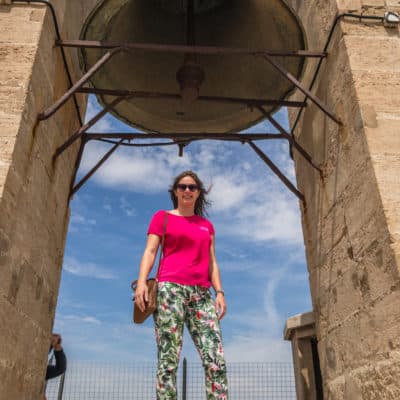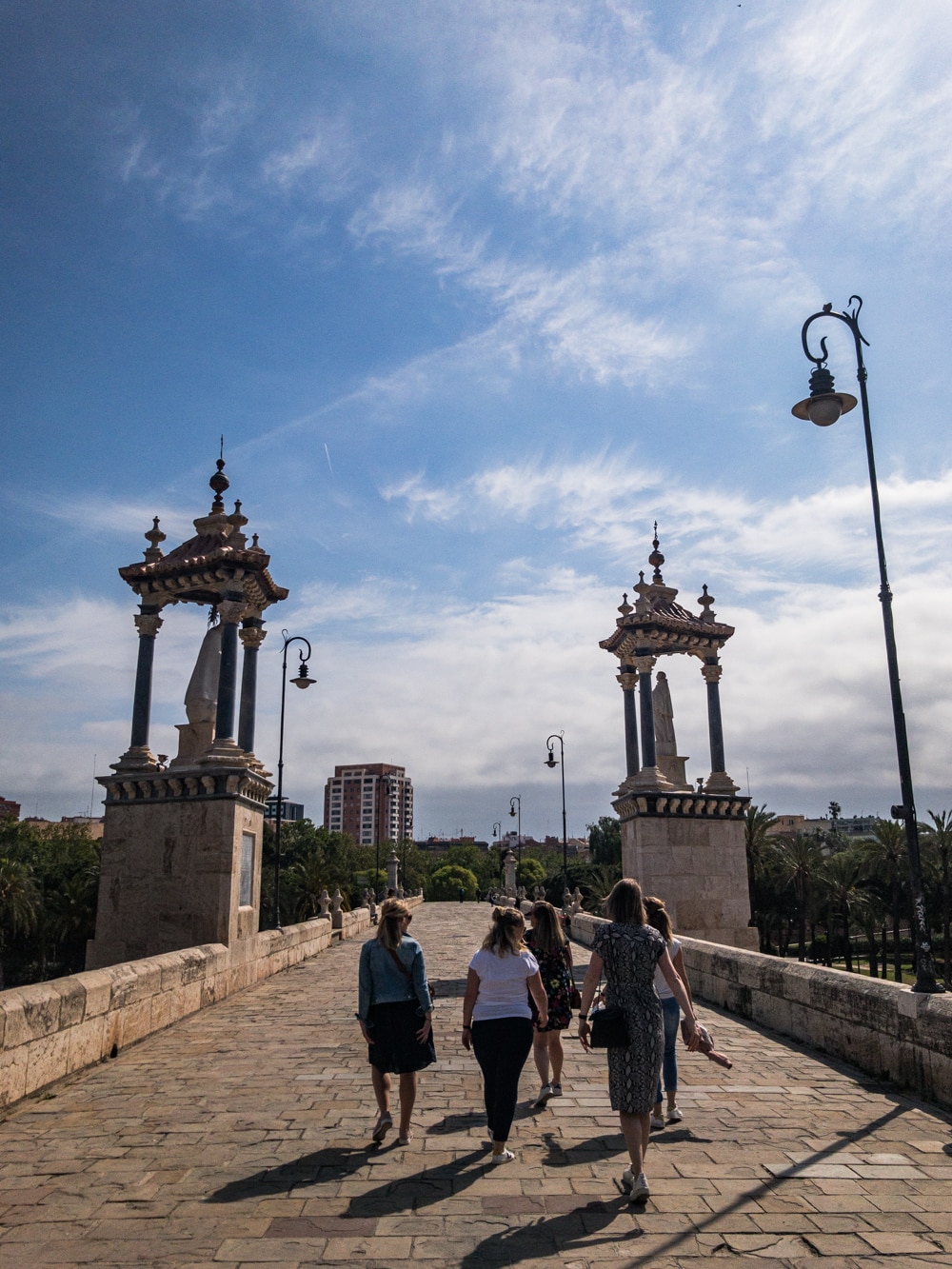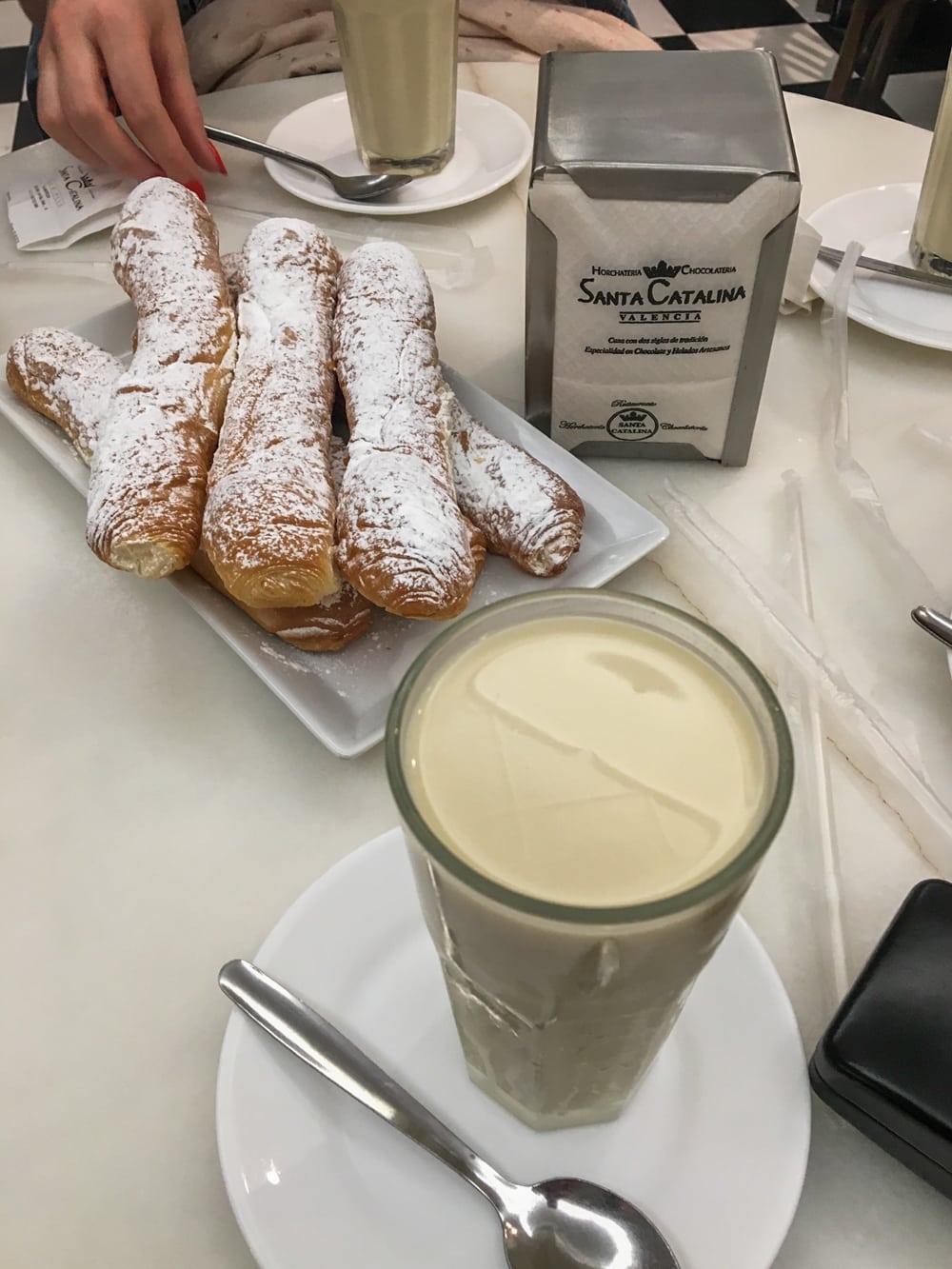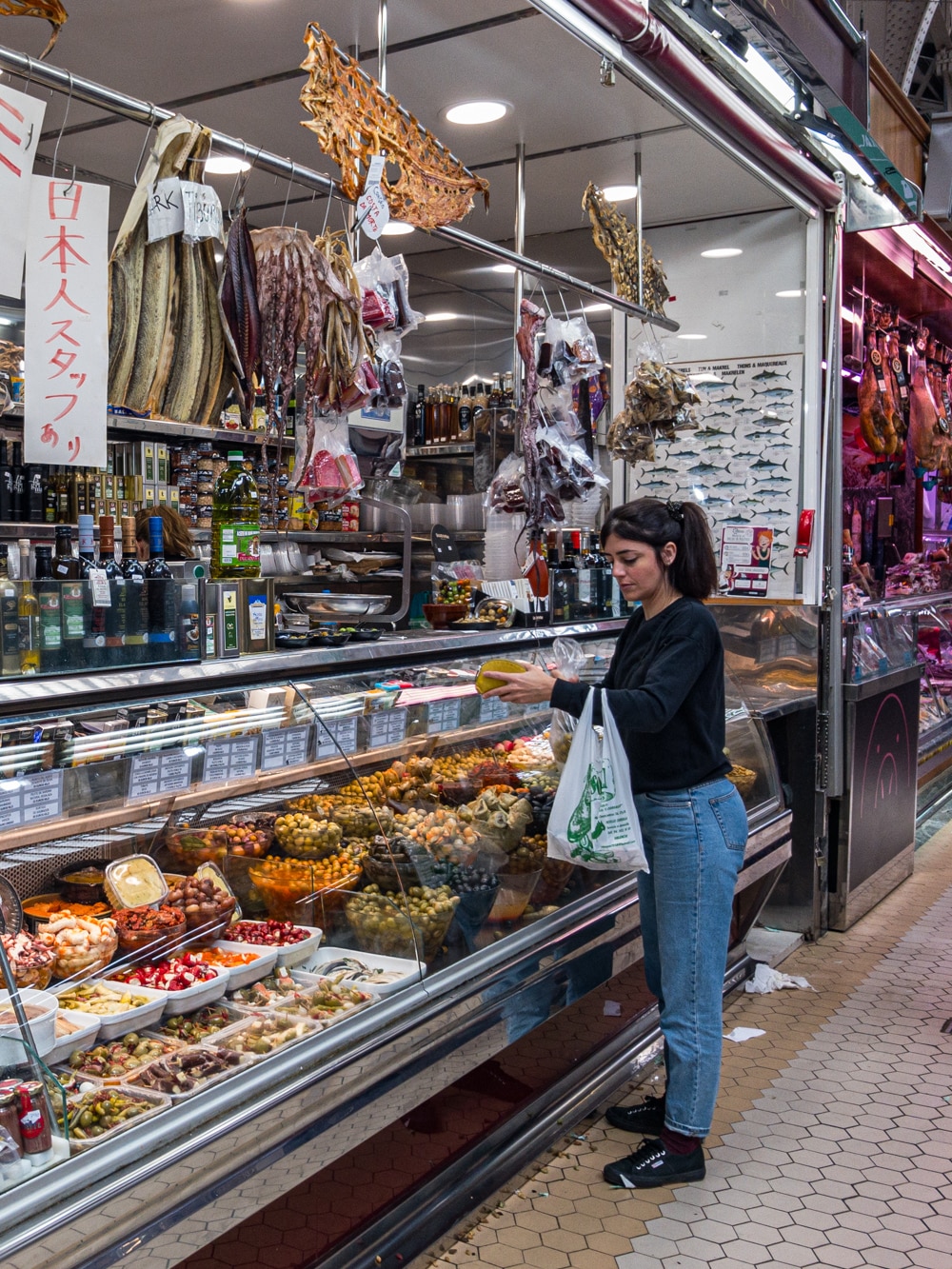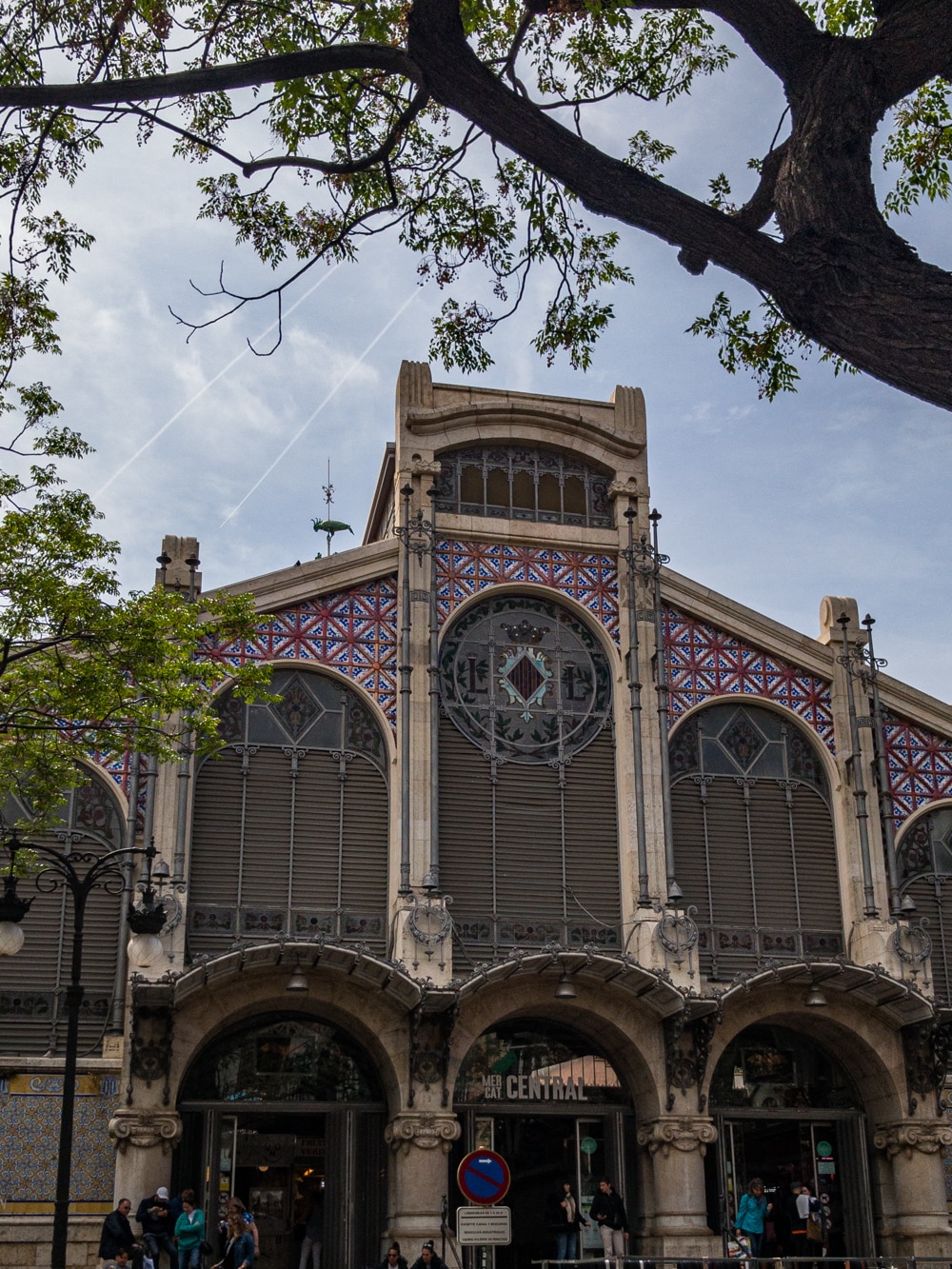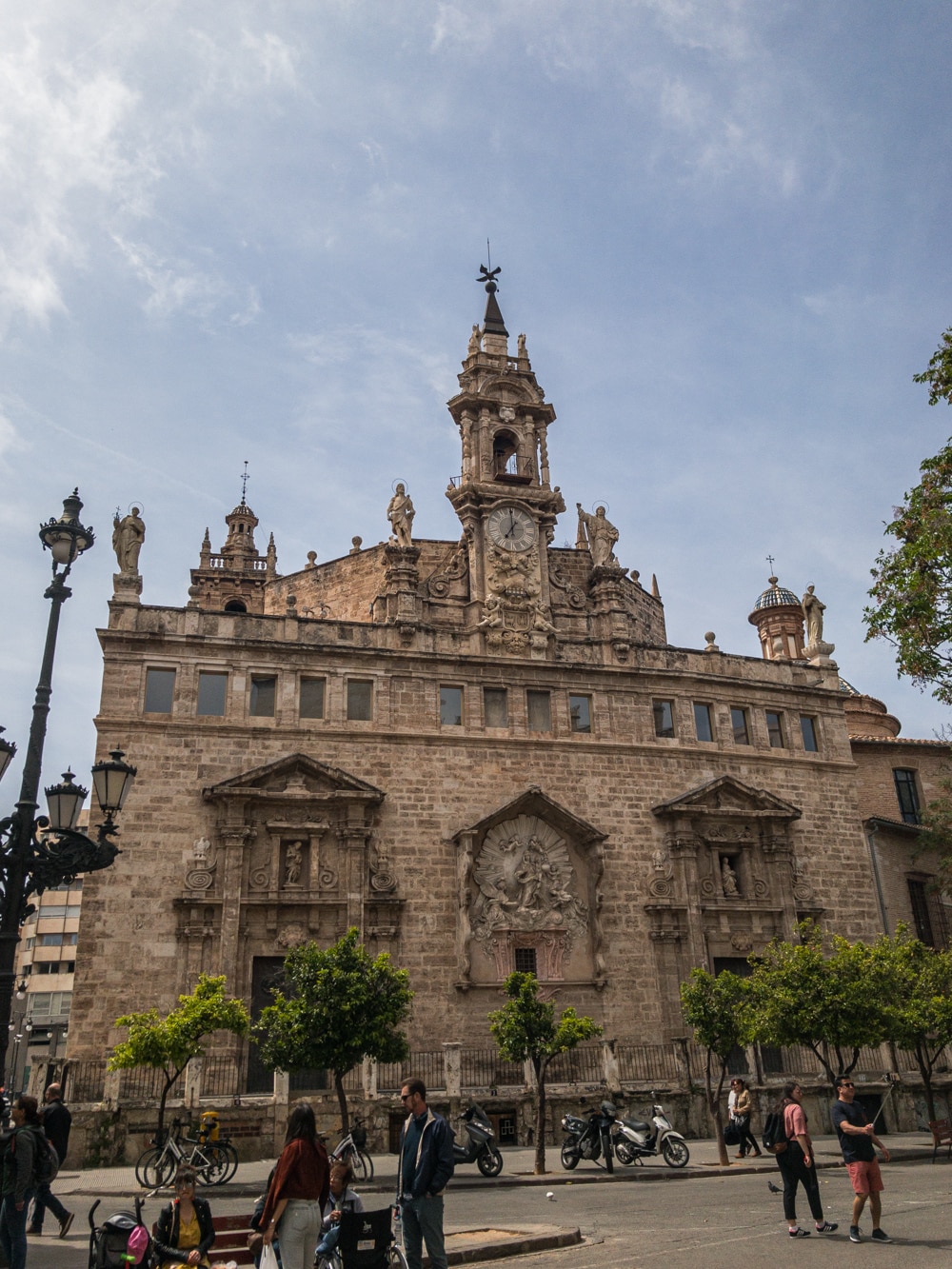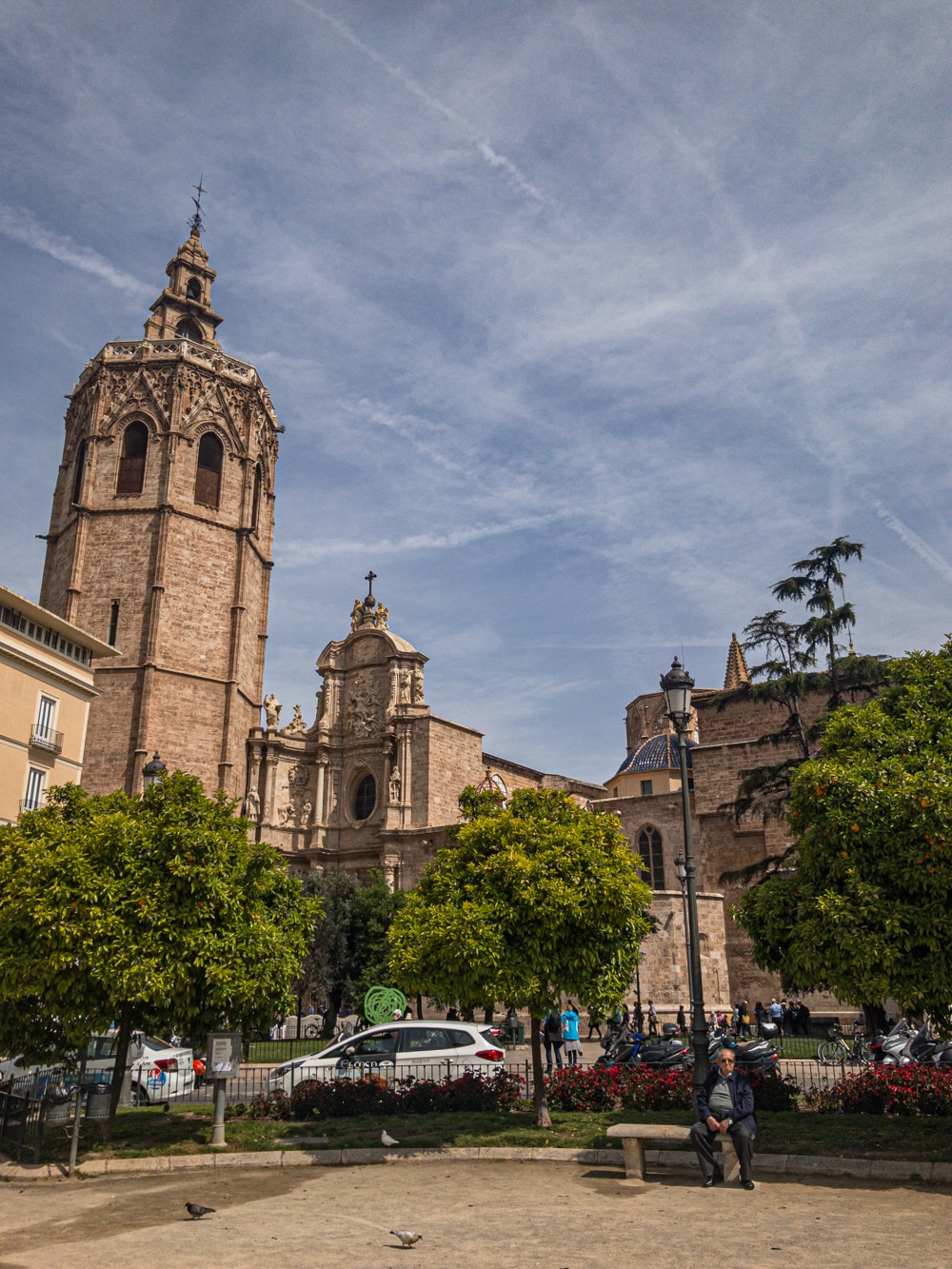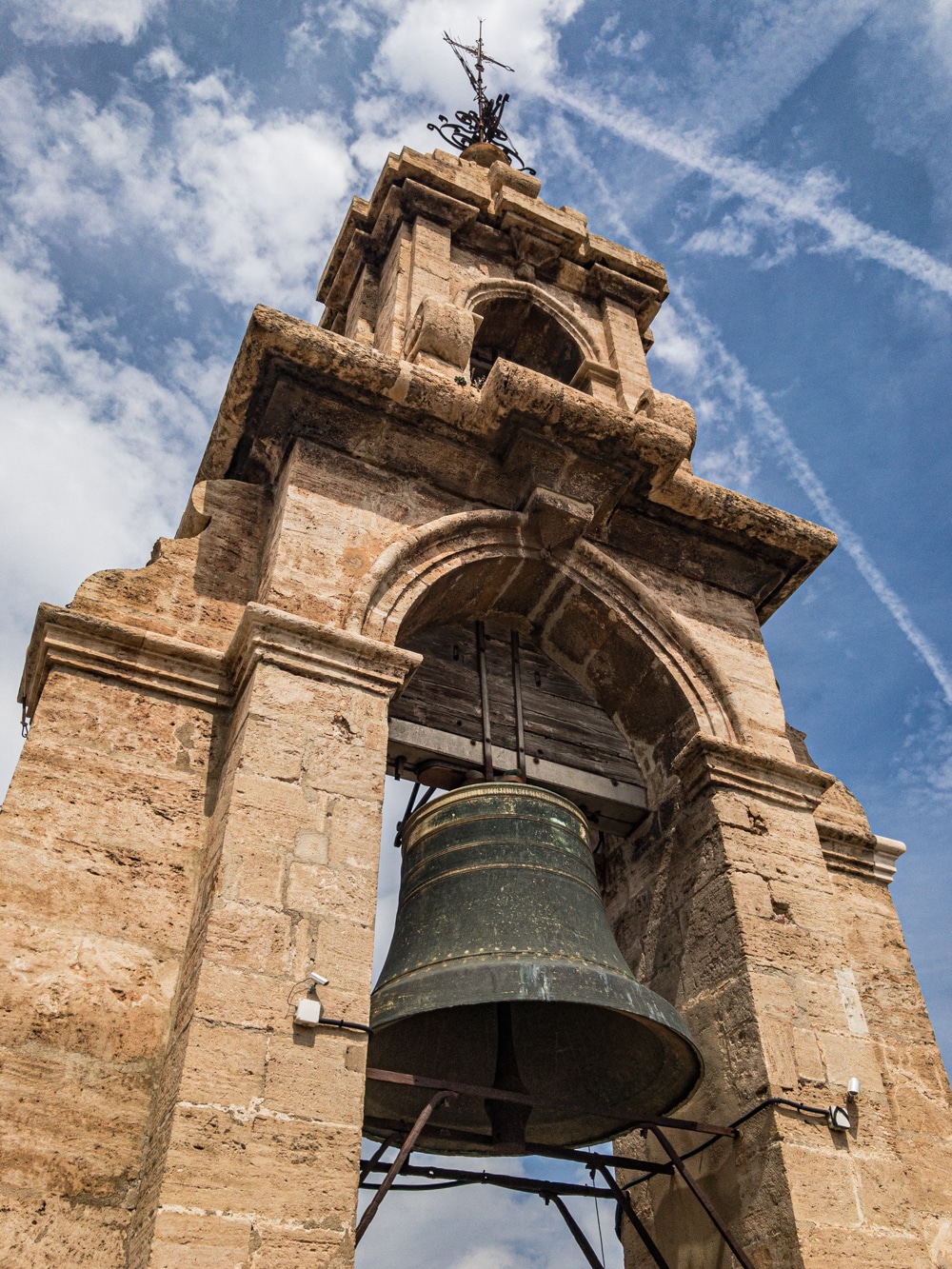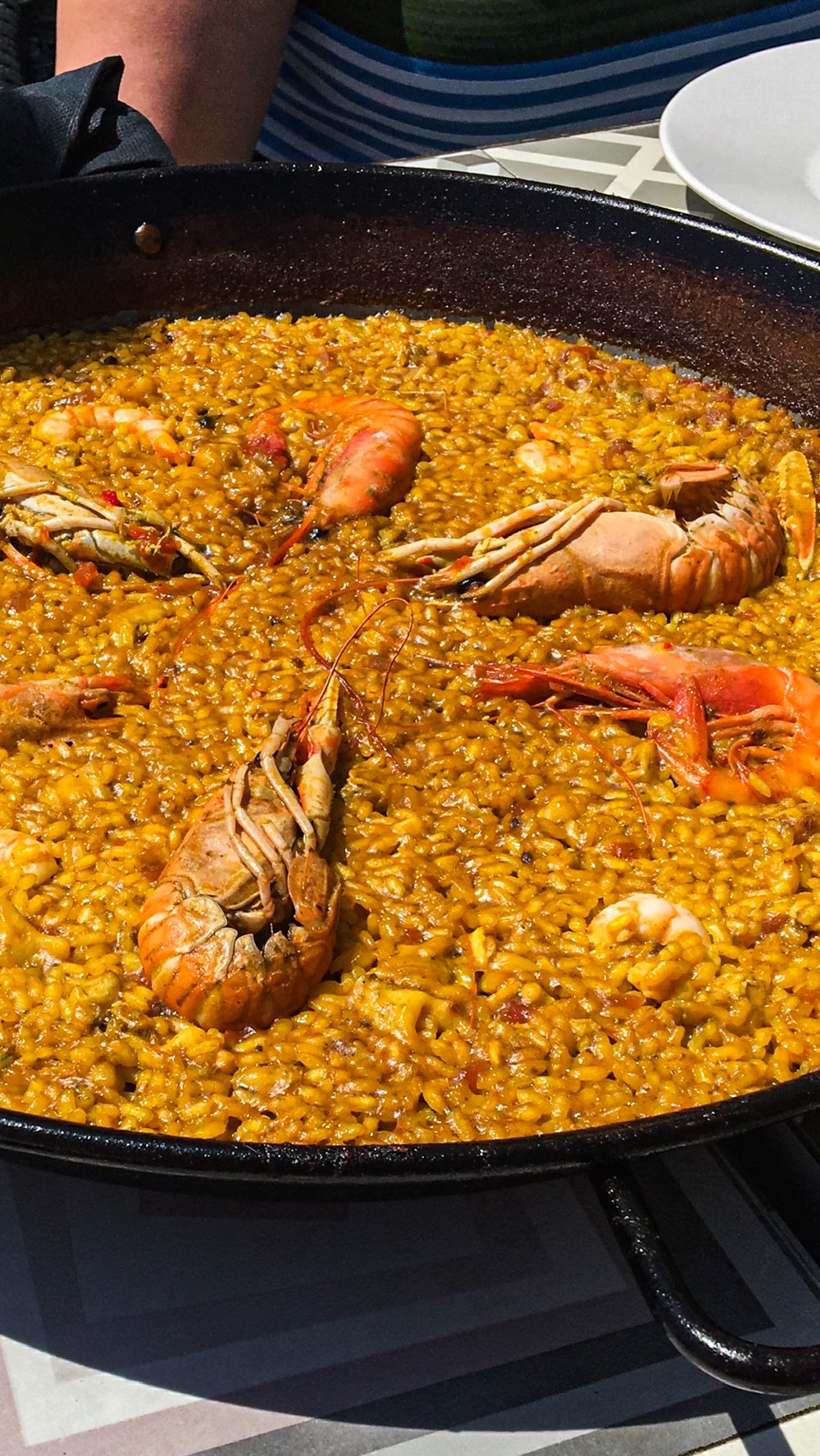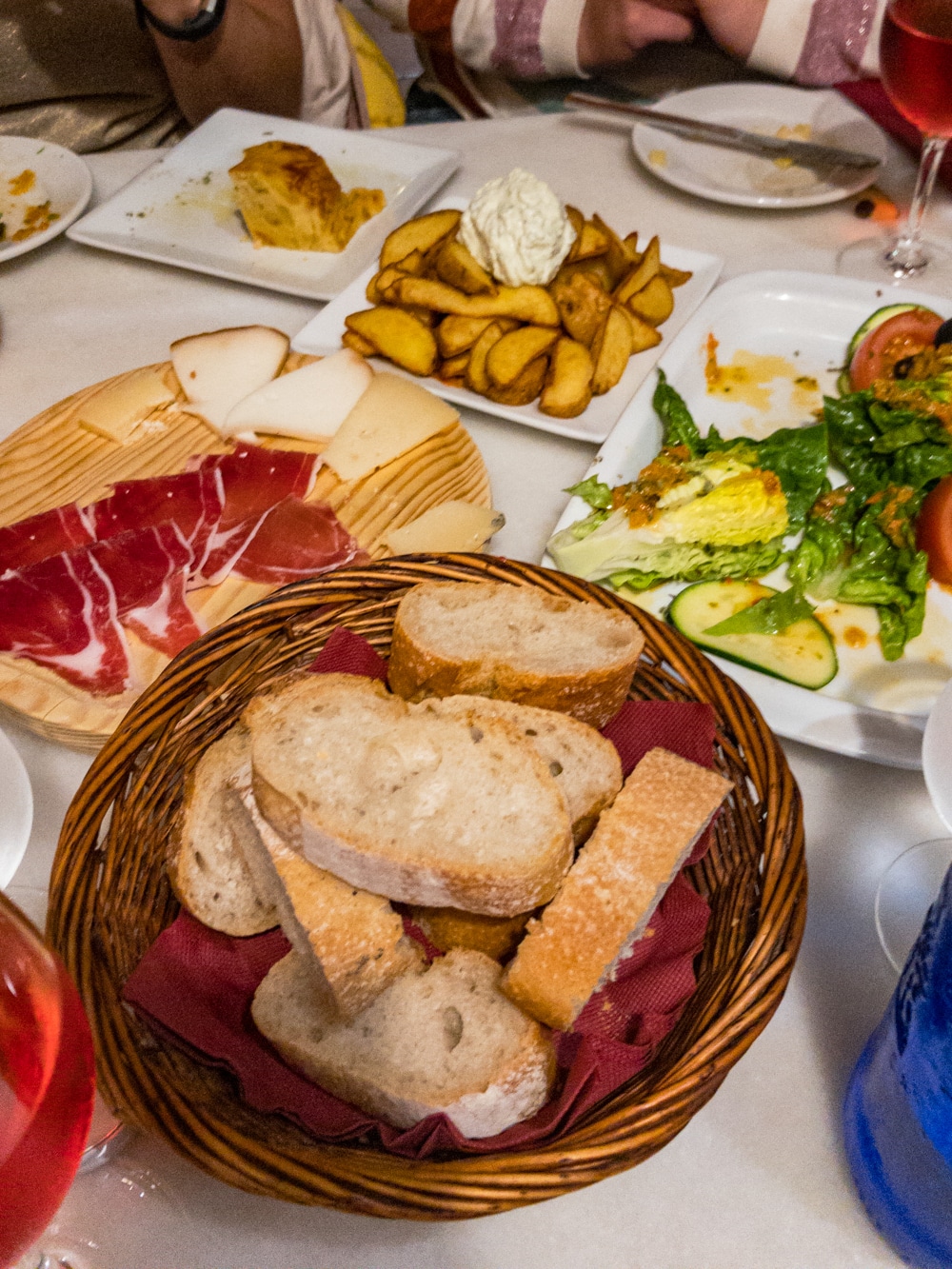Valencia is a port city on the eastern coast of Spain, and a pretty popular city trip destination in Europe. It’s rather small compared to Barcelona or Madrid, but definitely worth a visit. Although the city is best known for the futuristic buildings of The City of Arts and Sciences, it has a lovely old town as well, not to mention its 9 km long park. Keep reading to find out what to see and do in Valencia.
Did you know? Valencia has its own language: Valencian or Southern Catalan.
TIP: The locations in this article are clickable and will take you to the corresponding marker on the map. You can find the map on the right of your screen, or by clicking the map icon on the bottom if you’re on mobile.
1. Visit the City of Arts and Sciences
The City of Arts and Sciences, known to locals as La Ciutat de les Arts i les Ciènces, is arguably the most famous landmark in Valencia. The complex consists of 6 photogenic buildings, among which the largest aquarium in Europe, and an interactive science museum. Definitely a must see in Valencia!
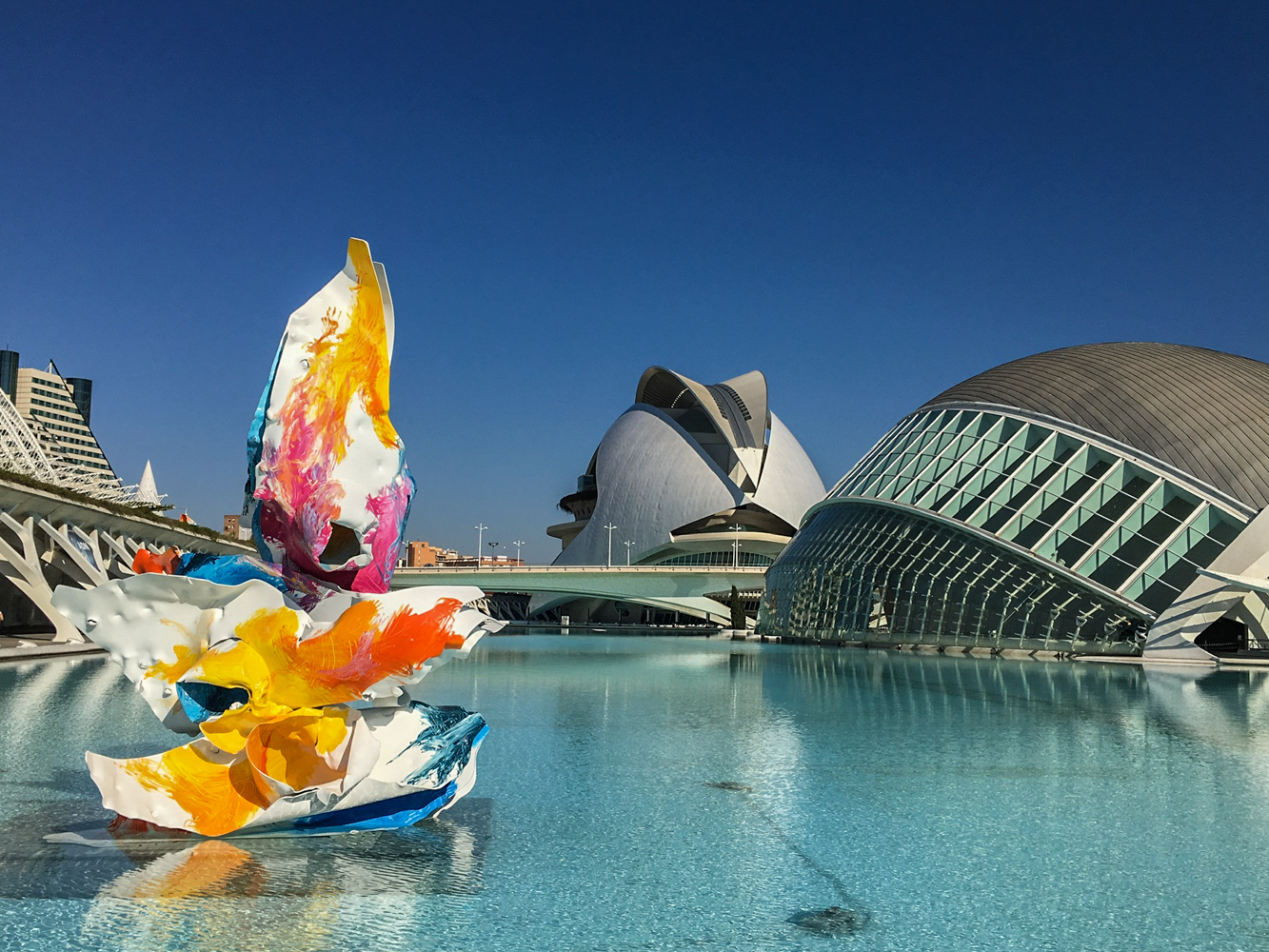
2. Join a Valencia bike tour
Since Valencia is pretty flat and full of well-maintained bike lanes, a (guided) bike tour is the ideal way to quickly get to know this Spanish city on your first day there.
We did a Dutch bike tour with Lokaal Valencia, as recommended by our friend Sanne on En Sanne Reist, her Dutch travel blog. However, there are plenty of Valencia bike tours in English to choose from too.
A Valencia highlights bike tour is probably the best way to be introduced to the city. If you like a beer in between cycling, the Valencia Beer Bike Tour might be for you.
Another option is the Sunset Bike and Catamaran Tour in Valencia, which combines a shorter highlights bike tour with a catamaran cruise to enjoy the sunset while sipping a (free) cocktail.
3. Bike through the Turia Gardens
The Turia Gardens are a 9 km long park in Valencia. The Turia River used to flow there, but due to constant flooding of the city, it was rerouted to flow south of the city instead. After some discussion on what should occupy the dry riverbed, the people of Valencia got their green space.
The Turia Park has bike lanes, walking paths, sports areas, and is popular with locals and tourists alike. Kids love to play at Gulliver Park, a big playground in the form of Gulliver from the book “Gulliver’s Travels”.
On the west end of the park there’s Valencia’s zoo Bioparc, and on the east end there’s the futuristic City of Arts and Sciences. To explore everything in between, like the Flower Bridge and Palau de la Música (a concert hall), it’s best to rent a bike.
There are many bike shops throughout Valencia, but the one next to Gulliver Park is especially interesting. At Cyclobikes you can’t just rent regular bikes, but also kid bikes and 3 to 6 people cycles. They offer bike tours as well.

4. Drink a refreshing glass of Horchata
You haven’t properly visited Valencia if you haven’t tried horchata, a famous local drink. Horchata (de chufa), spelled orxata in Valencian, has a chalky texture, looks like milk, but is made of tiger nuts (chufa). It’s non-alcoholic and pretty sweet.
Horchata is served ice-cold, usually with a farton on the side. Fartons are long semi-sweet soft pastries which you’re supposed to dip in your horchata.
Order a refreshing glass of Horchata in a Horchateria, or Orxateria. There are many to choose from in Valencia, even in the form of street stands, but the oldest one is Horchateria de Santa Catalina.
The text on the facade claims this horchateria has 2 centuries of tradition. They only serve horchata, farton, croissants, coffee, and ice cream. It reminded me a lot of Pasteis de Nata, thé spot to taste pastei de nata in Belem, Lisbon.
FYI: there was only 1 person in our group of 6 who really liked the horchata, so maybe order 1 drink to share?
If you want to learn more about this drink and visit the Horchata fields in the northern farmlands of Valencia, you might want to check out this Horchata Bike Tour.
5. Explore the old city centre of Valencia
The historical centre of Valencia, known as Ciutat Vella or Old City, is over 2000 years old. There are impressive buildings and gates through the city, so keep your eyes peeled and your camera ready. The historical centre of Valencia isn’t that big, so you can easily explore it by foot or by bike.
You can find more information on renting a bike in Valencia in our post about transportation in Valencia.
Serranos Towers
A nice spot to enter the Old City of Valencia is through the Serranos Gate. This well preserved landmark, also known as the Serranos Towers, or Torres or Porta dels Serrans, is 1 of 12 gates that used to be part of the ancient city wall around the Old City.
Walk over the pedestrian bridge, called Pont dels Serrans, towards the Torres dels Serrans for the most impressive view of the gate. You can climb the towers for a view of the city (€2 entrance fee, for free on Sundays), or just walk through the gate to enter the city.
Plaza de la Virgen
One of the most impressive squares in Valencia is without a doubt Plaza de la Virgen, with the impressive Valencia Cathedral as its eye catcher. Next to the cathedral is the Basilica of our Lady of the Forsaken, and in the middle of the square is the Turia Fountain, representing the Turia River.
If you happen to be visiting on a Thursday around noon, you’ll see the Water Court, or the Tribunal de las Aguas de la Vega de Valencia, convene outside the Door of the Apostles of the Valencia Cathedral. It’s an old tradition (there’s discussion on how old exactly), where decisions regarding the irrigation system from the Turia River are made.
Plaza del Ayuntamiento
Another lovely square in Valencia is Plaza del Ayuntamiento, translated City Hall Square. It has the post office and, you guessed it, city hall.
There’s no entrance fee to check out the inside of the post office or city hall. Get your travel buddy to wait outside for a photo of you on the city hall balcony.
Mercado Central
Valencia has a bunch of markets spread throughout the city, with Central Market being presumably the most famous.
The Central Market of Valencia, known as Mercat Central or Mercado Central to locals, is a huge market building, filled with nearly 300 food stalls. Most of them sell fresh produce, like meat, cheese, and fruit. Some of them have cups of finger food for sale as well.
The gorgeous building of Mercat Central opened in 1928. Its most impressive feature is the large stained glass dome. So even if you don’t need groceries, it’s worth a visit.
Take note that the market is opened from 7:30 to 15:00 from Monday to Saturday. We noticed that around 14:30 lots of stalls were already packing up.
La Lonja de la Seda
Across from Mercado Central you can find 2 other remarkable buildings: Iglesia de San Juan del Mercado and La Lonja de la Seda.
Església de Sant Joan del Mercat, or Church of John’s Saints, was originally built on the site of an old mosque, back in 1240. After a couple of reconstructions and an exterior reform, the main façade is now pretty impressive.
The Silk Exchange, known as Llotja de la Seda to locals, is a UNESCO World Heritage Site illustrating the power and wealth of Valencia at the time. Built in the 15th century for trading silk, you can now pay a €2 (~ $2.20) entrance fee to admire the towering columns and ornate halls. La Lonja de la Seda is open from Monday to Saturday from 10:00 until 19:00.
TIP: On Sundays and holidays you can visit the Valencia Silk Exchange for free. Note that it’s only open between 10:00 and 14:00 on those days.
Want to learn more about the silk trade and its importance to the city of Valencia? Check out this guided Silk Trade Tour in Valencia.
6. Climb El Miguelete
The famous octagonal-shaped bell tower of the Valencia Cathedral is known as El Miguelete or Torre del Micalet. For a €2 (~ $2.20) entrance fee, you can climb the 207 steps for a nice 360° view over Valencia. Can you spot Valencia’s most famous landmarks?
The spiral staircase is rather narrow, so going up and down is done in groups. Wait for the green light to start ascending or descending. Allow for about an hour in total for a proper visit to El Miguelete.
Keep in mind that it can be very windy at the top of El Micalet. The high fences might make a nice panorama shot difficult, but they’re there for your safety. Oh, and try to avoid being up there when the bell rings on the hour, because you’re right below it.
7. Stroll along the Valencia beaches and marina
The Valencia beaches are just a stone’s throw away from the city itself. You can easily get there by bike or bus, we’ve tried both. Check out our post on transportation in Valencia for more information on taking the bus or renting a bike.
There are actually 3 adjacent beaches in Valencia: El Cabanyal or Las Arenas Beach, Malvarrosa, and Patacona or Alboraia Beach. El Cabanyal is the beach closest to the city and the marina, and probably the most touristy, Patacona is the furthest away, and (therefore) not that busy. Here are the better and less expensive (but also busy!) restaurants.
Valencia’s stretch of almost 4 km (~ 2.5 miles) of sandy beach has volleybal courts, deckchairs, public toilets and showers. Along the beach there’s the Maritime Promenade, lined with palm trees and restaurants.
In between the beach and the marina is Marina Beach Club. Perfect for sipping cocktails by the (infinity) pool with a view over the beach. No getting in here without a reservation, wether you’re coming to the restaurant, or looking for a sun bed near the pool or on the beach. Side note: we’ve read children aren’t allowed.
If you walk past Marina Beach Club, you can continue up the ramp towards Panorama Restaurant, which is located on a heightened promenade. The view over the sea is quite stunning from here, probably even more so at sunset.
Definitely worth the walk, but don’t go on there on your bike, it’s a bumpy ride and there’s no ramp at the end. Rather walk, and descend the stairs at the end to walk back along La Marina, the port of Valencia.
8. Eat paella for lunch
Paella is the famous Valencian rice dish, a typical lunch for locals. Although seafood paella is probably the most famous type of paella, the Valencian paella actually has rabbit, chicken and sometimes snails. Head to Valencia Beach to try some!
The 6 of us shared a seafood and vegetable paella at Dos Lunas Beach. There’s a large sunny terrace with a view of the shipping containers in the port. The paella was just okay, which might explain why it wasn’t that busy.
Did you know? The crusty crispy bottom of the paella is intentional and called socarrat.
The best paella in Valencia is supposed to be served at La Pepica, located on the beach front. The restaurant exists over a 100 years (doesn’t that say more than any TripAdvisor review?), but unfortunately was fully booked when we visited. Let us know in the comments if you’ve tried their paella!
Another option is joining a paella cooking class. That way, you’ll have an awesome recipe to replicate at home! Check out these paella cooking classes in Valencia.
9. Eat tapas for dinner
Tapas originated in Spain, but are now served all over the world. They’re small portions of food, appetizer-sized, so order several of them to make a whole meal. You can stay in 1 place, or move from bar to bar.
Pinchos are a type of tapas from northern Spain. They’re usually served on slices of bread, with a toothpick in it to keep the topping in place. Different toothpicks represent different prices, and at the end of the night, your bill will be made based on the toothpicks on your plate.
The more expensive tapas on the menu are usually sharing plates, called raciones, like cured ham and cheese platters for example.
Tapas hour starts at around 20:30 in most of Spain. The most authentic tapas bars don’t have “Tapas Bar” in their name, and are rather small, without much seating. A perfect example is Tasca Angel.
We wanted to have tapas at El Patio de Pepa, a small pinchos and tapas bar. Unfortunately it was exceptionally closed when we visited.
We asked for a recommendation from a barber down the road, which lead us to La Bodeguilla del Gato. It’s an old, authentic tapas restaurant, not too big, with friendly staff and good food. Note that it only opens at 20:30, like most restaurants in Valencia.
Joining a tapas tour is always a good idea as well. You’ll get some more info and insider tips on the best tapas (bars) by a local. Or combine tapas and wine tasting in this Wine & Tapas Tour with a sommelier guide in Valencia.
10. Enjoy a typical Valencian cocktail
Agua de Valencia, or Aigua de Valencia, translated Valencian Water, is a heavenly cocktail, served for the first time in 1959. Made from cava or champagne, orange juice, vodka and gin, this refreshing drink is best enjoyed with friends on a sun soaked terrace. It’s usually served in pitchers, and dangerously good!
We had the best Agua de Valencia on the lovely terrace of Bar & Kitchen. Go try it and let us know what you think!
Where to stay in Valencia?
The 6 of us shared a small apartment at Valenciaflats, less than a 5 minute walk from the City of Arts and Sciences.
Check out the rates and availability at Valenciaflats or look through all accommodation options in Valencia here:
When we got back from Valencia, a friend of ours gave us an interesting tip about where to stay in Valencia. Apparently ILUNION Hotels throughout Spain employ people with some type of disability. ILUNION Valencia 3 is a three-star SEC hotel (Special Employment Centre) and ILUNION Valencia 4 is a four-star SEC hotel. Worth checking out if you ask us!
Even though Valencia isn’t that big a city, there are plenty of things to see, do and taste. Hope you’ll have an equally wonderful time as we did!
Like it? Pin it!
Did you find this post helpful? Help us spread the word by sharing this post or pinning the following image.


